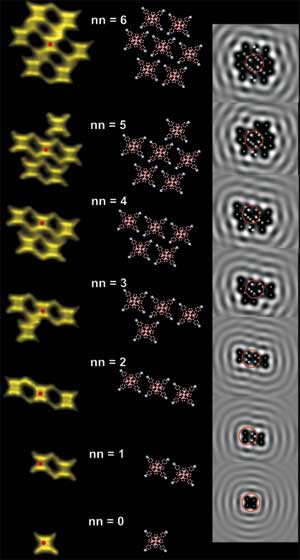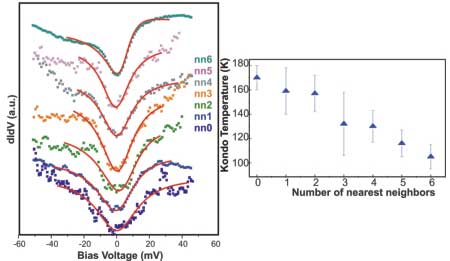| Posted: Jan 09, 2007 | |
Manipulation of the Kondo effect for molecular spintronic applications |
|
| (Nanowerk Spotlight) A control over spin-electron interactions is vital for development of spintronic devices and for quantum computation. When a magnetic impurity is surrounded by free electrons, a realignment of the electron spins occurs below a critical temperature due to spin-electron interactions; this causes an increase in resistivity of the material – a phenomenon known as the Kondo effect. The Kondo effect has been observed in a wide range of systems including single atoms/molecules, quantum-dots, and carbon nanotubes, however two-dimensional molecular Kondo systems have yet to be explored. Molecules with magnetic properties recently have great appeal as they offer an ideal platform to advance the fundamental understanding of spin related mechanisms, and can act as templates for molecular spintronic device fabrication due to their propensity for spontaneous self assembly. By manipulating nearest-neighbor molecules with a scanning tunneling microscope tip researchers now were able to tune the spin-electron coupling of the center molecule inside a small hexagonal molecular assembly in a controlled step-by-step manner. This variation of Kondo effect might be useful for instance for storing or manipulating data in spintronic memory devices. | |
| Spintronics (short for "spin-based electronics") is an emergent technology which exploits the quantum propensity of electrons to spin as well as making use of their charge state. The spin itself is manifested as a detectable weak magnetic energy state characterized as "spin up" and "spin down". The spin-electron interaction mechanism is not fully understood yet. | |
| In new research conducted by Professor Saw-Wai Hla at the Nanoscale & Quantum Phenomena Institute at Ohio University for the first the Kondo effect in two-dimensional molecular self-assemblies is reported. | |
| "We manipulated a Kondo resonance originated from the spin-electron interactions between a two-dimensional molecular assembly of TBrPP-Co molecules and a Cu(111) surface at 4.6 K using a low temperature scanning tunneling microscope" Hla explains to Nanowerk. "Moreover, we are able to tune the Kondo temperature between 105° K and 170° K by manipulating the number of nearest neighbor molecules with the STM-tip. This novel experimental scheme provides insight into the underlying spin-electron interaction mechanism." |  |
| The experiments are done by using TBrPP-Co (cobalt porphyrin molecules) on a copper crystal surface at 4.6° K (- 269° C or -451° F). The molecules are deposited by vacuum evaporation on the copper surface to self assemble to form ribbon-like monolayer islands. A scanning tunneling spectroscopy then was used to determine the Kondo signature. | |
| "To manipulate the Kondo effect, we first create a small hexagonal unit of molecules" says Hla. "Then by removing one molecule at a time with the STM-tip, we study the Kondo effect at the center molecule. We find that by reducing the number of near- neighbor molecules, the Kondo temperature increases." | |
| A movie on Hla's website shows how the molecular hexagon is created. | |
| Hla explains how, initially, the center molecule is completely surrounded by six molecules and the Kondo temperature is measured as 105° K. This value is the same as the ones measured inside full ribbon structures indicating that the second or third nearest neighbors in the molecular assembly do not play a key role for the observed Kondo resonance. | |
| Next, one of the six surrounding molecules from the ‘hexagon’ is removed and the Kondo signature is determined above the same center molecule again. This time there is an increase in the Kondo resonance. The increased Kondo temperature means that the spinelectron coupling is now enhanced. Continued reduction in the number of nearest neighbor molecules increases the Kondo temperature of the center molecule further. Finally, for the isolated molecule, the Kondo temperature reaches 170° K. | Kondo temperature tuning. A sequence of STM images of different ‘nn’ molecules created by removing one molecule-at-a-time with the STM-tip (left) from the ‘hexagon’ and corresponding models (middle). The calculated electron standing wave patterns reveal a gradual exposing of the center molecule (indicated with a red circle) to the surface state electrons. Here white and black colors in the calculated images represent higher and lower electron densities, respectively. The black region under the molecular clusters indicates reduction of surface electronic charge density. (Image: Dr. Hla) |
| "Thus, using this manipulation scheme, we are able to tune the Kondo temperature between 105° K and 170° K, which amounts to a ∼38% temperature variation" says Hla. | |
 |
|
| (left) The dI/dV spectra are measured at each step by positioning the tip above the center molecule (indicated with red dot). The spectra are vertically and horizontally displaced for clarity. Horizontal displacements of 3 to 10 meV are taken for the spectra representing nn6, nn5, nn4, nn2 and nn1. (right) The plot of Kondo temperature as a function of the number of nearest neighbors. (Images: Dr. Hla) | |
| To further verify the mechanism, the researchers measure the Kondo resonance over the molecules located at the sides, edges and corners of the three molecular assemblies. Here, the measured Kondo signatures agree well with the values obtained from the manipulation experiment having the same nearest neighbors. | |
| Hla's recent research has been reported in a paper, titled "Manipulation of the Kondo Effect via Two-Dimensional Molecular Assembly", that was published in the December 23, 2006 issue of Physical Review Letters. | |
| "We are currently working to achieve a better control over molecular spin by single molecule manipulations" Hla explains the current direction of his group's work. | |
 By
Michael
Berger
– Michael is author of three books by the Royal Society of Chemistry:
Nano-Society: Pushing the Boundaries of Technology,
Nanotechnology: The Future is Tiny, and
Nanoengineering: The Skills and Tools Making Technology Invisible
Copyright ©
Nanowerk LLC
By
Michael
Berger
– Michael is author of three books by the Royal Society of Chemistry:
Nano-Society: Pushing the Boundaries of Technology,
Nanotechnology: The Future is Tiny, and
Nanoengineering: The Skills and Tools Making Technology Invisible
Copyright ©
Nanowerk LLC
|
|
Become a Spotlight guest author! Join our large and growing group of guest contributors. Have you just published a scientific paper or have other exciting developments to share with the nanotechnology community? Here is how to publish on nanowerk.com.
